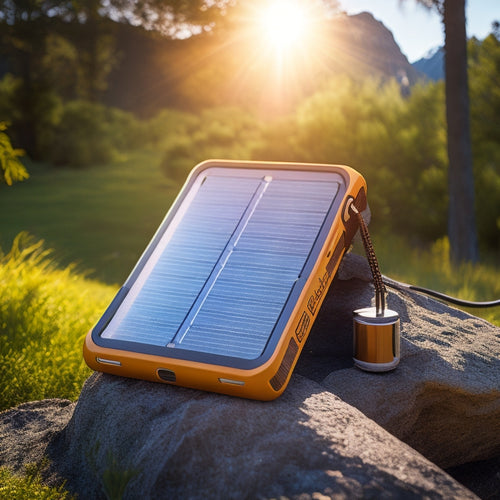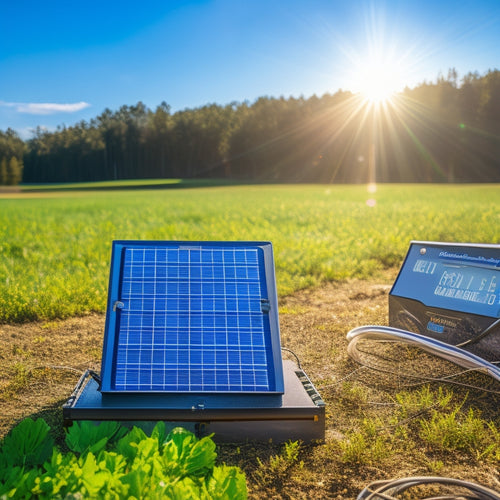
What to Look for in Modern Solar Lights
Share
When you're choosing modern solar lights, focus on several key features. Look for high-efficiency solar panels with at least 20% efficiency, guaranteeing peak energy capture. Check the battery type—lithium-ion batteries last longer and require less maintenance than lead-acid options. Consider smart sensor technology for better performance, including motion detection that conserves energy by activating lights only when needed. Pay attention to lumen ratings to guarantee adequate brightness for your space and select adjustable brightness options for versatility. Finally, examine durability regarding weather resistance to guarantee long-lasting performance. There's more to investigate about these essential features.
At a Glance
- Look for high-efficiency solar panels that exceed 20% to maximize energy capture and performance.
- Ensure the solar lights have adjustable brightness features for customizable illumination based on specific needs.
- Check for smart sensor technology, including motion detection, to conserve energy and enhance safety.
- Opt for durable, weather-resistant materials to ensure longevity and resilience against harsh conditions.
- Consider the lumens rating to select appropriate brightness levels suitable for your outdoor space.
Energy-Efficient Lighting Solution
When you consider solar lights, you'll want to assess solar panel efficiency and battery longevity.
High-efficiency panels maximize energy capture, ensuring your lights stay bright even on cloudy days, which is essential for energy independence.
Meanwhile, longer-lasting batteries mean less frequent replacements, giving you a reliable and low-maintenance lighting solution.
Solar Panel Efficiency
Solar panel efficiency plays an essential role in maximizing the energy output of solar lights, ensuring you get the most from your investment. The effectiveness of a solar panel in converting sunlight into usable energy directly impacts the performance of your solar lighting system.
Thanks to solar technology advancements, modern panels can achieve higher efficiency rates, often exceeding 20%. These advancements mean that even on cloudy days or in shaded areas, your solar lights can still produce adequate energy.
To maintain this efficiency, regular solar panel maintenance is vital. Dust, debris, and weather elements can reduce the amount of sunlight reaching the panels, leading to decreased power generation.
Simple cleaning a few times a year can go a long way in preserving their performance. Additionally, positioning your solar lights in ideal sunlight locations can enhance their energy absorption.
Battery Longevity
Battery longevity is vital for the reliability of solar lights, as it directly affects how long your lighting system can operate without interruption. The heart of your solar lighting setup is the battery, which stores energy generated by the solar panels.
To guarantee you get the most out of your battery, you should follow a few battery maintenance tips. First, always keep the solar panels clean and unobstructed to maximize charging efficiency. Regularly inspect the battery for signs of wear or corrosion, and verify all connections are secure.
When it comes to battery replacement options, consider the type of battery your system uses. Common types include lead-acid, lithium-ion, and nickel-cadmium. Each has its pros and cons regarding lifespan, cost, and environmental impact.
Knowing when to replace your battery is significant; typically, lead-acid batteries need replacing every 1-2 years, while lithium-ion batteries can last up to 5 years or more.
Cost-effective Long-term Investment
When considering solar lights, it's crucial to evaluate both the initial purchase price and their long-term energy savings potential.
While the upfront cost may be higher than traditional lighting, the reduced electricity bills and minimal maintenance can lead to significant savings over time.
This makes solar lights a cost-effective investment for your property.
Initial Purchase Price
Investing in modern solar lights can seem intimidating due to their initial purchase price, but this expense often proves to be a cost-effective long-term investment.
When you evaluate the initial cost benefits, it's crucial to take into account how these lights can save you money over time. While the upfront costs may be higher than traditional lighting options, the absence of wiring and low maintenance needs can greatly reduce your overall expenditure.
Budget considerations should also factor in the longevity and durability of solar lights. Many units are designed to withstand harsh weather conditions, meaning you won't have to frequently replace them.
Additionally, you'll enjoy the flexibility of installation without needing an electrician, further minimizing your costs.
Energy Savings Potential
Many homeowners find that modern solar lights offer significant energy savings, making them a cost-effective long-term investment. By utilizing solar energy, these lights reduce your reliance on conventional electricity, leading to lower utility bills over time.
With advancements in solar energy trends, the efficiency of solar panels has improved dramatically, enabling more effective energy capture even in less-than-ideal conditions.
When you opt for solar lighting, you're not just saving money; you're also contributing to a positive environmental impact. Each kilowatt-hour of energy you don't draw from the grid helps decrease greenhouse gas emissions, aligning with a more sustainable lifestyle.
Plus, many solar lights require minimal maintenance, further enhancing their cost-effectiveness.
As energy costs continue to rise, investing in solar lighting can be a smart financial decision. You'll enjoy the freedom of reduced energy expenses while also playing a role in promoting renewable energy solutions.
In an era where sustainability is increasingly essential, modern solar lights stand out as a practical choice that enables you to contribute to a greener future while enjoying significant savings.
Smart Sensor Technology
Smart sensor technology in modern solar lights enhances efficiency and performance.
With features such as motion detection, these lights activate only when movement is detected, conserving energy and prolonging battery life.
Additionally, light sensitivity adjustments allow the lights to respond to changing ambient light conditions, ensuring ideal illumination when needed.
Proper battery maintenance is essential for maximizing the longevity and effectiveness of these solar lights.
Motion Detection Features
How can motion detection enhance your outdoor lighting experience? By integrating smart sensor technology, modern solar lights can greatly improve safety and convenience around your property.
When you choose lights with motion detection features, you gain the ability to monitor activity in real time, ensuring your outdoor spaces are illuminated only when needed. This not only conserves energy but also minimizes light pollution.
With wireless connectivity, these lights can communicate effortlessly with your smartphone or smart home systems, allowing you to receive notifications whenever motion is detected. This feature enables you to stay informed, enhancing your sense of security.
Additionally, customizable settings let you adjust sensitivity and detection range, tailoring the performance to meet your specific needs.
Whether you want the lights to activate upon detecting a passing animal or a visitor approaching your door, you can easily fine-tune the settings.
Light Sensitivity Adjustments
Alongside motion detection, light sensitivity adjustments play an essential role in optimizing your outdoor lighting system. These features allow your solar lights to automatically activate based on ambient light levels, guaranteeing they illuminate your space effectively.
With dusk to dawn functionality, your lights can adjust seamlessly as day shifts to night, providing consistent coverage without manual intervention.
When considering solar light placement, you'll want to verify they're positioned where they can receive adequate sunlight during the day. This maximizes battery efficiency and extends operational hours at night.
Smart sensor technology enables your lights to gauge their surroundings, turning on when it's dark and off when it's light, conserving energy for when you truly need it.
Choosing units with adjustable sensitivity settings can further enhance performance. You might prefer lights that react to varying degrees of darkness, making sure they're not overly sensitive to nearby streetlights or passing cars.
This way, your outdoor space remains well-lit without unnecessary interruptions. Ultimately, integrating light sensitivity adjustments into your solar lighting system equips you to maintain a lively, illuminated environment while enjoying the freedom of automated functionality.
Selecting Based on Brightness Levels
When selecting solar lights, pay attention to lumens as they indicate brightness levels. Higher lumens provide more light, which is essential for safety and visibility.
Additionally, consider options with adjustable brightness features to customize illumination based on your needs.
Integrating solar lights with a home energy storage system can enhance overall energy efficiency and sustainability, allowing you to utilize environmental impact and sustainability benefits while illuminating your outdoor spaces effectively.
Lumens Measurement Importance
Understanding lumens measurement is vital for selecting the right solar lights for your outdoor space. Lumens, by definition, quantify the total amount of visible light emitted by a source. When choosing solar lights, you'll want to take into account lumens as an important brightness measurement that directly affects the ambiance and functionality of your area.
Higher lumens indicate brighter lights, which can be beneficial for safety and visibility, especially in pathways or driveways. For instance, if you're illuminating a large garden or outdoor gathering space, you might opt for lights with 500 lumens or more.
Conversely, for a cozy patio or decorative lighting, 100 to 300 lumens might suffice. It's important to match the lumens output to your specific needs.
Too little light can lead to dark, unwelcoming spaces, while excessive brightness can be overwhelming. By understanding and applying lumens measurement effectively, you can guarantee your solar lights provide the right level of brightness, enhancing both the aesthetic and practical aspects of your outdoor environment.
This way, you'll enjoy your space to its fullest potential, all while embracing the freedom that effective lighting offers.
Adjustable Brightness Features
How can adjustable brightness features enhance your outdoor lighting experience? By allowing you to customize the light levels, these features provide both functionality and flexibility in your outdoor spaces. You can set the brightness according to the occasion, whether it's a cozy evening or a lively gathering, enhancing your design aesthetics and ensuring your space feels just right.
Here's a quick overview of adjustable brightness options:
| Brightness Level | Best For | User Customization |
|---|---|---|
| Low | Ambience setting | Soft, warm lighting |
| Medium | Social gatherings | Balanced light for visibility |
| High | Security purposes | Bright illumination |
With adjustable brightness, you're not just lighting up your space; you're creating an atmosphere customized to your needs. This flexibility enables you to adapt your outdoor lighting to different scenarios, ensuring it complements your design aesthetics perfectly. Accept user customization and enjoy the freedom to control your environment, making your outdoor areas more inviting and functional.
Longer Lifespan Than Conventional Options
When you choose modern solar lights, you're opting for durability and weather resistance that outlast traditional options.
These lights are designed to withstand harsh environmental conditions, ensuring they remain functional longer.
This longevity not only saves you money on replacements but also reduces maintenance efforts.
Durability and Weather Resistance
Modern solar lights are engineered for exceptional durability and weather resistance, making them a superior choice compared to traditional lighting options. You'll find that high-quality materials, such as impact-resistant plastics and corrosion-resistant metals, are commonly used in their construction. These materials guarantee that your solar lights can withstand harsh environmental conditions, from intense sunlight to heavy rain and snow.
Seasonal performance is critical when choosing solar lights. Unlike conventional options that may falter in extreme weather, modern solar lights are designed to operate efficiently year-round. They often feature advanced solar panels that maximize energy absorption even during limited daylight hours, assuring reliable operation regardless of the season.
Moreover, many models include built-in protective features, such as waterproof casings and UV-resistant coatings, which greatly extend their lifespan. This durability not only saves you money on replacements but also allows you to enjoy the freedom of outdoor lighting without the constant worry of wear and tear.
Frequently Asked Questions
How Do Solar Lights Perform in Cloudy Weather Conditions?
Solar lights can still operate in cloudy weather, though their efficiency drops. You'll notice reduced brightness and shorter operating time, but many modern designs optimize energy storage, ensuring decent performance even during overcast conditions.
Can Solar Lights Be Easily Moved or Repositioned?
Think of solar lights as your guiding stars. You'll appreciate their weather resistance and installation ease; moving or repositioning them is a breeze, allowing you to adapt your outdoor space to your changing needs effortlessly.
Are Solar Lights Safe for Pets and Wildlife?
Solar lights are generally safe for pets and wildlife, as they emit low levels of light and heat. However, consider pet safety and wildlife impact when placing them to avoid disrupting natural behaviors.
What Maintenance Do Solar Lights Require Over Time?
Solar lights require minimal maintenance. You'll need to clean the solar panels regularly to maximize efficiency and replace batteries every few years to guarantee peak performance. Staying proactive keeps your lights bright and functional.
How Do I Choose the Right Location for Solar Lights?
To choose the right location for solar lights, guarantee ideal solar panel orientation for maximum sunlight exposure. Consider light intensity requirements, placing them in areas that receive direct sunlight for several hours each day.
Explore More
Incorporating modern solar lights into your outdoor space is a smart choice, offering energy efficiency, long-term savings, and advanced features like smart sensors. For instance, a homeowner in California saved over $300 annually on electricity by switching to solar lights equipped with motion sensors, which only illuminate when needed. By considering brightness, lifespan, and cost-effectiveness, you can enhance your property while minimizing environmental impact. Choose wisely, and enjoy the benefits of a sustainable lighting solution.
Related Posts
-

Fastest Solar Chargers for Emergency Power
When choosing the fastest solar chargers for emergency power, you need to focus on features like rapid charging capab...
-

Choosing the Right Solar Power Charge Controller
Choosing the right solar power charge controller is crucial for maximizing energy efficiency and extending battery li...
-

Top Solar Powered Camping Fans for Camping Enthusiasts
If you're a camping enthusiast, a solar-powered fan can be a transformative element for your outdoor experience. Thes...


